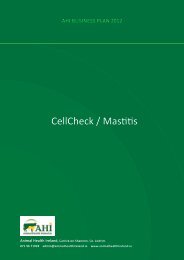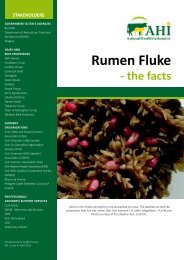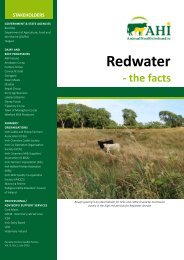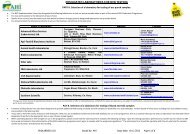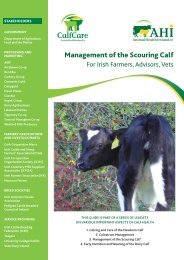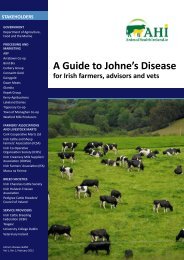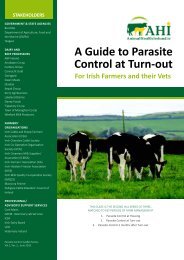Calving and Care of the Newborn Calf - Animal Health Ireland
Calving and Care of the Newborn Calf - Animal Health Ireland
Calving and Care of the Newborn Calf - Animal Health Ireland
You also want an ePaper? Increase the reach of your titles
YUMPU automatically turns print PDFs into web optimized ePapers that Google loves.
5<br />
5<br />
Improve your calving skills<br />
• The ability to deliver a live calf <strong>and</strong> healthy cow, at<br />
an assisted calving, can vary due to inadequate<br />
skills <strong>and</strong> lack <strong>of</strong> practice, as only a minority <strong>of</strong><br />
cows require assistance <strong>and</strong> few <strong>of</strong> <strong>the</strong>se are<br />
difficult calvings.<br />
• You can improve your calving skills by observing<br />
how your local vet deals with a problem calving<br />
<strong>and</strong> discussing with him or her how to improve<br />
your techniques.<br />
• Having good calving equipment (e.g. non-slip<br />
calving jack, disinfected coloured calving ropes,<br />
lubricant, arm-length gloves) in <strong>the</strong> calving unit<br />
will facilitate good calving technique. Coloured<br />
ropes will ensure you don't lose <strong>the</strong> ropes in <strong>the</strong><br />
straw bedding.<br />
TIPS:<br />
• ensure <strong>the</strong> cow is st<strong>and</strong>ing before attempting<br />
to correct a wrongly presented calf<br />
• put ropes on above <strong>the</strong> fetlock, ensuring that<br />
<strong>the</strong> knots are not on <strong>the</strong> sides <strong>of</strong> <strong>the</strong> legs<br />
• only pull when <strong>the</strong> cow forces <strong>and</strong> relax <strong>the</strong><br />
ropes when she relaxes<br />
• pull on alternate legs until <strong>the</strong> head emerges<br />
<strong>and</strong> rotate <strong>the</strong> calf after <strong>the</strong> chest emerges to<br />
prevent a hiplock.<br />
Good technique is particularly important<br />
where a calving jack is used as it can cause<br />
severe injuries to both <strong>the</strong> cow <strong>and</strong> <strong>the</strong> calf if<br />
used incorrectly.<br />
Rotate <strong>the</strong> calf after <strong>the</strong> chest emerges<br />
Check <strong>the</strong> calf for breathing <strong>and</strong> alertness<br />
Clean jack <strong>and</strong> ropes directly after each calving to minimise<br />
disease spread



